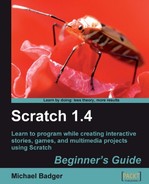When we program, we solve problems. In order to solve problems, we think, take action, and reflect upon our efforts. Scratch teaches us to program using a fun, accessible environment that's as easy as dragging and dropping blocks from one part of the screen to another.
In this book, we will program games, stories, and animations using hands-on examples that get us thinking and tinkering. For each project, we start with a series of steps to build something. Then, we pause to put our actions into context so that we can relate our code to the actions on Scratch's stage. Throughout each chapter, you'll encounter challenges that encourage you to experiment and learn.
As you begin working through the examples in the book, you won't be able to stop your imagination, and the ideas will stream as fast as you can think of them. Write them down. You'll quickly realize there are a lot of young minds in your home, classroom, or community group that could benefit from Scratch's friendly face. Teach them, please.
Chapter 1 provides an overview of Scratch, its features, and how it can help you teach 21st century learning skills to your children and students.
Chapter 2 guides us through the installation of Scratch on Windows, OS X, and Linux. This chapter also helps you run the Scratch programming environment from a USB flash drive.
Chapter 3 explores the Scratch interface and allows us to create some simple scripts that demonstrate how easily we can build a project. This is a high-speed tour of Scratch that gets us tinkering and thinking about what's possible.
Chapter 4 teaches us how to create an animated birthday card and a slideshow of our favorite photos.
Chapter 5 allows us to horse around as we develop a barnyard humor book that lets us narrate multiple scenes. There's no need to hold the applause.
Chapter 6 takes a classic pong game and gives it a little personality by adding a troll, switching levels, and keeping score.
Chapter 7 takes us to the fortune-teller, but before we learn the random answers to all our deepest questions, we must create our game using the Magic 8 ball's fortunes.
Chapter 8 uses mathematical formulas and graphs to help us answer the question, "Would you rather have a dollar that doubles every day or a lump sum of money?" The answer may surprise you.
Chapter 9 explains how to share your project with the Scratch community and how to promote it to you friends and fans.
Chapter 10 shows us how to connect a webcam and an external sensor board to our computer and delivers real-world stimuli as input to Scratch projects.
